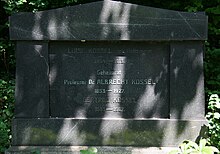Walther Kossel – Wikipédia, a enciclopédia livre
| Walther Kossel | |
|---|---|
| Walther Kossel (1928) | |
| Nascimento | 4 de janeiro de 1888 Berlim |
| Morte | 22 de maio de 1956 (68 anos) Tübingen |
| Sepultamento | Bergfriedhof (Heidelberg) |
| Nacionalidade | Alemão |
| Cidadania | Alemanha |
| Progenitores | |
| Alma mater | |
| Ocupação | físico, professor universitário, químico |
| Prêmios | Medalha Max Planck (1944), Plaqueta Röntgen (1956) |
| Empregador(a) | Universidade de Tubinga, Universidade de Quiel, Universidade Técnica de Gdańsk |
| Orientador(a)(es/s) | Arnold Sommerfeld |
| Instituições | Universidade de Quiel |
Walther Ludwig Julius Kossel (Berlim, 4 de janeiro de 1888 — Tübingen, 22 de maio de 1956) foi um físico alemão.


Kossel obteve um doutorado em 1911 na Universidade de Heidelberg, orientado por Philipp Lenard. Foi depois para Munique, onde obteve na Universidade Técnica de Munique sua habilitação. Aluno de Arnold Sommerfeld em Munique, foi a partir de 1921 professor de física teórica na Universidade de Quiel, onde foi em 1929/1930 reitor.[1] Em 1924 fo eleito membro correspondente da Academia de Ciências de Göttingen.[2]
Publicações selecionadas[editar | editar código-fonte]
- Walther Kossel Bemerkung zur Absorption homogener Röntgenstrahlen, Verh. D. Deutsch. Phys Ges (2) 16 898-909 (1914). Received 27 September 1914, published in issue No. 20 of 30 October 1914. As cited in Mehra, Volume 1, Part 2, 2001, p. 795.
- Walther Kossel Bemerkung zur Absorption homogener Röntgenstrahlen. II, Verh. D. Deutsch. Phys Ges (2) 16 953-963 (1914). Received 23 October 1914, published in issue No. 22 of 30 November 1914. As cited in Mehra, Volume 5, Part 2, 2001, p. 919.
- Walther Kossel Bemerkung zum Seriencharakter der Röntgenstrahlen, Verh. D. Deutsch. Phys Ges (2) 18 339-359 (1916). Received 31 August 1916, published in issue No. 15-18 of 30 September 1916. As cited in Mehra, Volume 5, Part 2, 2001, p. 919.
Referências
- ↑ «Rektoratsrede (HKM)»
- ↑ Holger Krahnke (2001). Die Mitglieder der Akademie der Wissenschaften zu Göttingen 1751-2001. Göttingen: Vandenhoeck & Ruprecht. p. 138. ISBN 3-525-82516-1
- Borisenko, Victor E. and Stefano Ossicini What is What in the Nanoworld: A Handbook on Nanoscience and Nanotechnology(Wiley-VCH, 2004) ISBN 3-527-40493-7
- Cao, Gouzhong Nanostructures and Nanomaterials: Synthesis, Properties, and Applications (Imperial College Press, 2004) ISBN 1-86094-415-9
- Gerhard Herzberg translated from German with the help of the author by J. W. T. Spinks Atomic Spectra and Atomic Structure (Dover, 1945)
- Mehra, Jagdish, and Helmut Rechenberg The Historical Development of Quantum Theory. Volume 1 Part 2 The Quantum Theory of Planck, Einstein, Bohr and Sommerfeld 1900 – 1925: Its Foundation and the Rise of Its Difficulties. (Springer, 2001) ISBN 0-387-95175-X
- Mehra, Jagdish, and Helmut Rechenberg The Historical Development of Quantum Theory. Volume 5 Erwin Schrödinger and the Rise of Wave Mechanics. Part 2 Schrödinger in Vienna and Zurich 1887-1925. (Springer, 2001) ISBN 0-387-95180-6
- Pauling, Linus The Nature of the Chemical Bond and the Structure of Molecules and Crystals: An Introduction to Modern Structural Chemistry (Cornell, 1960)
- White, Harvey Elliott Introduction to Atomic Spectra (McGraw-Hill, 1934)
| Precedido por Friedrich Hund | Medalha Max Planck 1944 | Sucedido por Max Born |


 French
French Deutsch
Deutsch